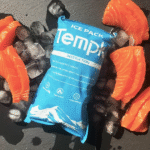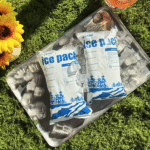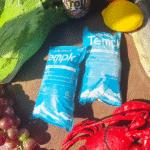Dry Ice Cubes vs Dry Ice Pack: Which Keeps Cold?
If you’re choosing between dry ice cubes dan a Paket es kering for time‑critical shipping, Inilah jawaban singkatnya: pick cubes for fast pull‑down and deep freeze, pick packs for cleaner handling and controlled release. In cold chain work, those choices decide hold time, keamanan, biaya, dan kepatuhan. This guide shows you exactly when to use each, with 2025‑ready workflows you can apply today.
-
When to use dry ice cubes vs a dry ice pack for vaccines, Biologi, dan makanan beku
-
How to size dry ice for 24–72 hour lanes with real‑world assumptions
-
Pack‑out designs that balance hold time, biaya, and condensation risk
-
Safety and compliance for CO₂ venting, pelabelan, dan dokumentasi
-
2025 tren in dry ice production, greener options, and reusable carriers
How do dry ice cubes and a dry ice pack differ for cold‑chain shipping?
Jawaban Langsung
Dry ice cubes deliver rapid cooling and long hold when massed; a dry ice pack delivers cleaner handling, lower dust, and steadier release. Use cubes for fast pull‑down below −40 °C; use packs when you need tidy, repeatable pack‑outs and easier SOP training. Expect higher surface contact (and frost risk) dengan kubus; expect gentler ramp rates with a dry ice pack.
Mengapa ini penting
Dalam praktiknya, you care about a shipment’s temperature curve, not just “cold.” Dry ice cubes expose more surface area and drive quick temperature drops—great for rapid stabilization, but they can create cold spots. A Paket es kering is pre‑formed CO₂ ice inside a sleeve or film that sublimates in a more uniform way. For diagnostic kits or last‑mile deliveries where techs rotate quickly, packs standardize the process and reduce handling errors. Both options must vent CO₂; neither is “sealed.” For complex lanes, labs often combine them: dry ice cubes for initial pull‑down, Paket es kering bricks for stability during transit.
How much dry ice pack or cubes do you need per shipment?
Details you can use
Estimate by balancing heat gain against sublimation. Typical field assumptions for insulated shippers: ambient 20–25 °C; 24‑hour heat ingress of ~6–12 W for a 12–18 L shipper; dry ice sublimation rates around 2.5–4.5 kg per 24 h depending on insulation and venting. For short lanes and smaller payloads, A Paket es kering mengatur (pre‑formed bricks) keeps handling simple. For longer lanes, menambahkan dry ice cubes mass to push hold time past 48–72 h.
| Decision Factor | Dry Ice Cubes | Paket es kering | Apa artinya bagimu |
|---|---|---|---|
| Cooling speed | Pull -down cepat (high surface area) | Sedang, more even | Faster stabilization vs smoother curve |
| Dust/handling | Higher dust; scoop or bag required | Low dust; tidy bricks | Easier training and SOP adherence |
| Pack‑out repeatability | Variable if hand‑filled | High—brick counts | Fewer packing errors |
| Hold time per mass | Strong when massed | Kuat, more predictable | Both work; packs reduce variability |
| Cold spots risk | Higher if touching vials | Lower with spacing | Use trays/dividers with cubes |
Tips dan saran praktis
-
Biologics in vials: Use a divider or tray. Menyimpan dry ice cubes from direct vial contact to avoid brittle fractures.
-
Kits and e‑commerce: Standardize on a Paket es kering menghitung (MISALNYA., four 500 g bricks) to cut training time and returns.
-
Risiko akhir pekan: Add a 25–30% buffer mass if a lane might slip from 48 to 72 h due to handoff delays.
Kasus dunia nyata: A reference lab switched from loose dry ice cubes to a 4‑brick Paket es kering SOP for 36‑hour regional lanes. Breakage dropped, pack errors fell 60%, and the lab extended safe time by ~8–10 hours thanks to more consistent sublimation and better venting.
When should you choose a dry ice pack vs dry ice cubes?
Jawaban Langsung
Choose dry ice cubes for deep‑freeze pull‑down, international air cargo, and heavy payloads. Choose a dry ice pack for clinic returns, small kits, and repeatable last‑mile routes. If the route is long and uncertain, combine both: cube bed on the bottom, Paket es kering bricks along the payload walls.
Scenario mapping
-
Frozen seafood export: Build mass with dry ice cubes; add a top layer of Paket es kering bricks to smooth the curve and reduce cold‑spot complaints.
-
Genetic testing kits: Use a fixed count of Paket es kering bricks. Include a clear SOP image in the carton.
-
Temperature‑sensitive reagents: Mulailah dengan dry ice cubes for pull‑down, then switch to packs in a mid‑mile hub if you re‑ice.
Safety and compliance for dry ice pack and dry ice cubes
Essential points
Es kering (co₂ solid) vents gas as it warms. Both Paket es kering Dan dry ice cubes need breathable space; never tape a shipper shut without vent paths. On air shipments, dry ice is a regulated dangerous good (Dan 1845). Packages require correct net mass declaration and hazard marking. In workspaces, manage CO₂ build‑up with ventilation and alarms per occupational safety practices.
| Topic | Dry Ice Cubes | Paket es kering | Kesimpulan Anda |
|---|---|---|---|
| Ventilasi | Essential; avoid sealed liners | Essential; film must vent | Always include vent channels |
| Pelabelan | Declare net mass of dry ice | Same requirement | Document the exact kilograms |
| Penanganan | Scoops, sarung tangan, dust mask | Sarung tangan; debu rendah | Packs reduce housekeeping load |
| Pelatihan | More variable | Easier to standardize | Faster onboarding with packs |
Pack‑out that avoids condensation and cold shock
Apa yang harus dilakukan
Use a liner bag that’s bukan airtight, add a paper spacer or corrugate between the payload and dry ice cubes, and position Paket es kering bricks along walls to even the temperature field. For glass vials, target a gentle ramp: cubes at the base, bricks on the sides, payload tray above a mesh or perforated board.
Micro‑trial tip: Before you roll out site‑wide, run two 24‑hour dummy shipments—one all cubes, one mixed with a Paket es kering. Compare probe curves and returns data. Pick the design with the fewest out‑of‑spec minutes, not just the longest hold time.
How do you size dry ice for 24–72 hours without guesswork?
Jawaban Langsung
Start from heat load, not from “how many bricks.” Estimate watts of heat leak from the container, convert to kJ over time, divide by dry ice latent plus sensible load. Then round up and add a weekend buffer. This works for both dry ice cubes dan a Paket es kering desain.
Cepat, practical estimator (aturan -dari ibuundi)
-
Find shipper loss: Good EPS shipper: ~8–12 W; premium VIP: ~2–4 W.
-
Pick duration: 24, 48, atau 72 jam.
-
Compute energy:
Watts × hours × 3.6 = kJ. -
Dry ice capacity: ~570–650 kJ per kg usable in real pack‑outs.
-
Mass needed:
kJ ÷ 600 ≈ kilograms. Add 20–30% safety stock.
Contoh
A 10 W shipper for 48 h needs: 10 × 48 × 3.6 = 1728 kJ.1728 ÷ 600 ≈ 2.88 kg, plus 30% buffer ≈ 3.7 kg es kering. Use 2 kg dry ice cubes under the tray and four 500 g Paket es kering bricks around the sides.
Sizing table you can adapt
| Shipper Class | Heat Leak (W) | 48 h Mass (kg) | What to load |
|---|---|---|---|
| EPS good | 10–12 | 3.5–4.5 | 2–3kg dry ice cubes + 2 kg Paket es kering |
| Pur / mid | 6–8 | 2.5–3.5 | 1.5–2 kg cubes + 1–1.5 kg packs |
| VIP premium | 2–4 | 1–2 | 0.5–1 kg cubes + 0.5–1 kg packs |
Quick safety margins that work
-
Uncertain pickup time: Add 0.5–1 kg.
-
Hot lane (30 °C+): Menambahkan 25%.
-
Large payload >8 kg: Prefer more dry ice cubes mass to control pull‑down.
Biaya, limbah, dan keberlanjutan: mana yang lebih baik?
Jawaban Langsung
Dry ice cubes are often cheaper per kilogram, especially when delivered in bulk. A Paket es kering can reduce hidden costs: faster training, less dust cleanup, and fewer damaged payloads. If you measure cost per successful delivery (not per kilogram), packs often win on short and mid routes.
Reducing CO₂ footprint while staying cold
-
Right‑size the shipper first. Lower heat leak means less CO₂ needed.
-
Use mixed loads. A cube base plus Paket es kering bricks keeps curves tight with less total mass.
-
Re‑ice at a hub. Split long routes into 2×36 h with a documented re‑icing SOP.
-
Source renewable CO₂ when available. Some suppliers now recover CO₂ from biogenic streams.
Customer story: A seafood exporter cut total dry ice mass by ~22% after moving to a cube‑plus‑pack design in VIP shippers, while complaint rates about “frozen outer fillets” dropped to near zero.
Langkah -langkah: pack with a dry ice pack (repeatable SOP)
-
Stage the payload in a tray with dividers; pre‑cool components.
-
Place two dry ice pack bricks on opposite walls; leave vents unobstructed.
-
Add a cube bed (jika diperlukan) under a perforated tray for faster pull‑down.
-
Insert the payload; add remaining Paket es kering bricks to fill wall channels.
-
Close the liner loosely so CO₂ can vent; jangan pernah menutup rapat.
-
Record net dry ice mass (kg) on docs and carton.
-
Apply hazard mark and arrows; include the SOP diagram on the inner flap.
2025 trends in dry ice cubes and dry ice pack solutions
Tinjauan Tren
Di dalam 2025, more shippers are switching to hybrid pack‑outs—dry ice cubes for early stage pull‑down, Paket es kering bricks for steady release and simpler training. Re‑icing programs at mid‑mile hubs are rising, enabled by IoT probes and lane analytics. Suppliers are expanding biogenic CO₂ recovery and offering standardized brick sizes to match common cavity designs.
Sekilas tentang apa yang baru
-
Standardized brick formats: 250 G, 500 G, and 1 kg Paket es kering sizes align with common 12–18 L shippers.
-
Cleaner handling: Lower dust films and glove‑friendly textures reduce GMP housekeeping load.
-
Thermal modeling tools: Easier calculators turn hours and ambient into a dry ice mass recommendation for both dry ice cubes and packs.
Wawasan pasar
Healthcare and seafood lanes still dominate dry ice demand, but direct‑to‑consumer frozen products continue to grow. The winning pack‑outs emphasize repeatability, simple SOPs, and fewer cold‑spot incidents. As premium insulation spreads, total dry ice mass per shipment drops, but consistency and documentation standards rise.
Pertanyaan yang sering diajukan
Q1: How long will a dry ice pack keep my shipment cold?
Most mid‑size shippers with four 500 g Paket es kering bricks hold 24–48 h at room temperature. Add bricks or dry ice cubes to reach 72 h. Venting and insulation quality decide the final number.
Q2: Are dry ice cubes colder than a dry ice pack?
Both are −78.5 °C. Cubes feel “colder” because they expose more surface area and speed pull‑down. A Paket es kering spreads cooling more evenly.
Q3: Can I use dry ice pack bricks on passenger aircraft?
Ya, es kering (Dan 1845) is allowed with limits and markings. Declare net mass and follow airline rules. Venting and labeling are mandatory.
Q4: Will dry ice damage vials or packaging?
Direct contact can cause brittle fracture or cracking. Add a tray or corrugate spacer. Tempat Paket es kering bricks along walls to avoid cold spots.
Q5: How do I prevent CO₂ buildup in vehicles or small rooms?
Ventilasi. Keep shippers in airy spaces, use CO₂ monitors where required, dan melatih staf. Both dry ice cubes Dan Paket es kering designs release gas as they warm.
Q6: What’s the best layout for mixed payloads?
Try a cube bed below a perforated tray with Paket es kering bricks on the sides. This balances pull‑down and uniformity.
Q7: How do I calculate net dry ice mass for paperwork?
Weigh the shipper empty, weigh again loaded, subtract payload and packaging. Record the dry ice cubes Dan Paket es kering totals in kilograms.
Interactive worksheet: 5‑minute dry ice sizing check
Your inputs
-
Shipper type (EPS / Pur / VIP)
-
Target hours (24/48/72)
-
Profil ambient (lembut / panas)
-
Massa muatan (kg)
Quick rules
-
EPS + 48 H + lembut: start at ~3 kg total; split between dry ice cubes Dan Paket es kering.
-
VIP + 72 H + panas: start at ~2.5–3 kg total; favor a mixed layout with extra side bricks.
-
Add 25–30% if any handoff might slip a day.
Pass/fail checklist
-
Venting path visible
-
Net dry ice mass recorded
-
No direct cube‑to‑vial contact
-
Brick count matches SOP image
Ringkasan dan Rekomendasi
Kunci takeaways
-
Dry ice cubes give fast pull‑down and long hold when massed.
-
A Paket es kering offers cleaner handling and repeatable brick counts.
-
Hybrid layouts often win: cube bed + side packs.
-
Right‑size by heat load, then add a 20–30% buffer.
-
Document net mass and venting; train for consistency.
Langkah selanjutnya (CTA)
-
Choose your primary format per lane: cubes for deep freeze, packs for repeatability.
-
Build a 24–72 h sizing table for your top three shippers.
-
Run two micro‑trials this week and lock the best SOP.
-
Butuh bantuan? Request a free pack‑out review from Tempk and get a lane‑specific calculator and SOP graphic.
Tentang tempk
We build reliable cold‑chain packaging that balances hold time, penanganan, dan biaya. Our team designs SOPs that cut packing errors while keeping your product in range. We offer validated shippers, Paket es kering format, and training support. Customers report reduced re‑icing events and fewer temperature excursions after adopting our mixed dry ice cubes plus pack layouts.
























